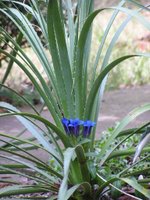
If you've a Mediterranean style garden, and you're looking for a plant that's a little bit different, then give Dasylirion Wheeleri a try.
It's been five years or so since I bought my plant and and it's turned out to be an excellent addition to the garden.
I've been so impressed with this plant, that, along with D.Texanum, I've grown more of them from seed.
Native to the South Western States of the U.S.A. and Mexico, Dasylirion Wheeleri, is one of those plants that has proved to be very useful to man.
It's been used for everything, from cattle feed to making baskets and the brewing of some fearsome sounding liquor called "Sotol", even the dried flower stems have been used as fence poles and for roofing.
D.Wheeleri, is another one of those "Looks like a pineapple top plants" only the leaves, rather than being short stubby things are very slender and anything up to four feet long.
They curve back very gracefully giving the whole plant a symmetrical look, they're also armed with a row of vicious spines along the leaf edges.
The leaf tips are peculiar, they tend to go brown and curl around in the shape of a piglets tail.
This doesn't mean there's something wrong with the plant, it's just something it does naturaly.
In nature, Dasylirion grow on sunny well drained hillsides both on Limestone and Granite formations.
They're not fussy about soil type, but excellent drainage is a must.
Mine grows in a sunny, well drained, south facing scree bed and since I planted it out some four years ago, it's stood temperatures down to -10c. without any protection.
Dasylirion, are best planted out in Spring, when all danger of frost has gone.
Water well until the plant is well established, don't use high nitrogen fertilizer, as this can lead to top growth at the expense of roots and it's root growth you need initially.
Once established, it's up to you how you look after it.
So, you can either leave it to nature and let it grow at its own pace, or you can speed things up a bit, by watering well during dry periods and feeding with high nitrogen fertilizer. Posted by: Mike.
These though are plants which need room, give them some space.
One word of warning, think twice about growing them if you have young children or boisterous pets, the spines can inflict a good deal of damage to little fingers.




